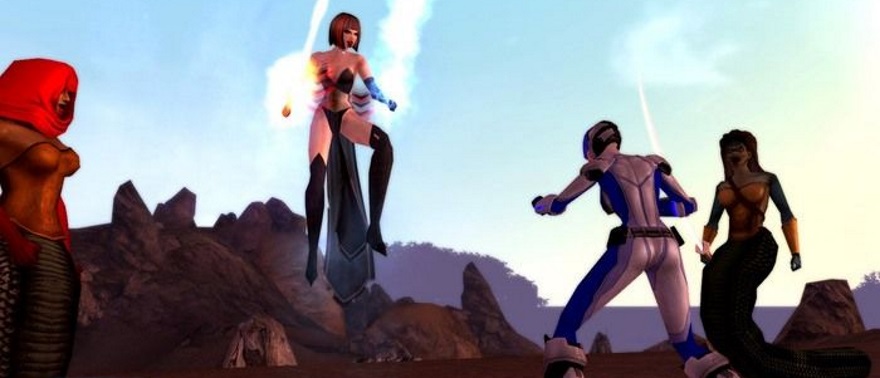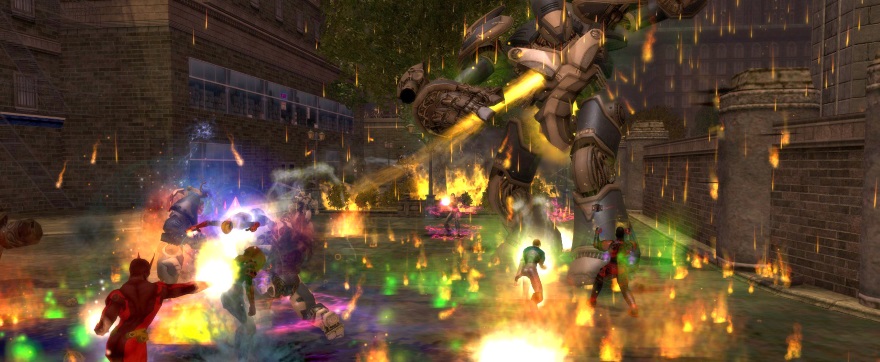
It’s always easy to look back at the making of City of Heroes and its first year with a memory tinted toward the good and away from the bad. Like most MMOs, City of Heroes exuded a mixed bag of quality — and its passionate fans certainly did not hold back on letting Cryptic know what they felt about the current state of the game and the choices that the studio made.
Every MMO, as part of its rite of passage, seems like it has to trigger at least one major controversy that sparks major nerdrage and gives fans a reason to grouse about it years later. It’s your New Game Enhancements, your Trammels, your Monoclegates, and your Real IDs.
So naturally City of Heroes was due for at least one of these bad calls to come along, and that it surely did. A little over a year after the game launched, a decision was made to course-correct what the devs saw as a problem and the players saw as an essential part of their happy fun time. You know where I’m going with this. Oh yes, you do.

Enhancement diversification
One point of contention between the players and the developers in those early years is that the community felt that Cryptic continued to nerf things that everyone loved or wanted to get better, such as Issue 5’s Global Defense Reduction. This wasn’t just in their minds; Cryptic (read: Jack Emmert) was fanatical about character balance and making sure that everyone was progressing more or less the same through the game. This led to a lot of nerfs until 2006, when the team downsized by 75% and was forced to focus on improving its current content and pleasing its existing playerbase.
Before City of Heroes came to that, however, it had to go through its darkest hour ever with October 2005’s Issue 6. Coming alongside the launch of City of Villains (see below), Issue 6 introduced a major balance feature that instantly became one of the most despised the game ever saw. It was called “Enhancement Diversification.”
To understand what ED was, you have to have a passing familiarity with how City of Heroes’ gear worked. Instead of sporting different armor pieces with stats attached, superheroes equipped “enhancements” to modify specific powers. Some of these would reduce the cooldown, lower the stamina cost, or increase the damage and intensity (among other things). The problem, in the developers’ eyes, was that players had quickly learned that by stacking the same type of strong enhancements to the same power, they would create “broken” powers that were too strong or imbalanced in some respect.
So with Issue 6, Cryptic introduced diminishing returns under the Enhancement Diversification umbrella. After the third enhancement of a particular type, it was no longer statistically profitable to keep doing the same, so the player would be strongly encouraged to diversify into other enhancement types.
If this was in the game on Day One, it wouldn’t have been a big deal, but after a year and a half of operation, players had grown used to customizing their powers the way they wanted. And they did not want this to change.
People really, really loved their perma-hasten and other tweaked abilities. There wasn’t a full-scale riot or anything, but players were quite miffed and unwilling to drop this particular grudge against Cryptic even years later.
Cryptic did admit that ED hurt the game, at least in the short term. “There is one nerf that I did that we lost a couple thousand people on,” Jack Emmert told Gamasutra in 2008. “It was called Enhancement Diversification… and that really did make people mad.”

City of Villains
While superheroes struggled with the changes to their power setups, a whole new group was moving into the neighborhood.
Until Issue 6, City of Heroes focused on, well, heroes. You were on the side of Good and Right, unless you roleplayed against type, and there was nothing to be done about it. Then came October 2005’s City of Villains, and the dark yang to the light yin fell into place.
City of Villains was, in effect, both a standalone MMO (it didn’t require the base City of Heroes game to play) and a de facto expansion. In any case, it finally allowed players to roll up the bad guys, gals, zombies, and robots and unleash a little mayhem and terror on the new zones of the Rogue Isles. The idea wasn’t that you were a homicidal maniac but rather that you were a villain who recently broke out of a high-security jail and was trying to build up a criminal empire for yourself.
The expansion added five new archetypes which were made out of new and recycled powersets. One of the most notable was the Mastermind, a pet master who commanded a rampaging horde of various minions. PvP also took shape, with heroes and villains duking it out in special zones.
Players got to meet and work with the villainous organization of Arachnos and its various signature baddies over the course of their adventures. Issue 6 and City of Villains also contained a graphic engine update to improve the game’s visuals.
Cryptic later reported that while City of Villains was well-received and -reviewed, it only brought in about 60,000 or so new people to the game. In fact, the MMO saw a better return on developer investment through regular updates, which always saw “several thousand people re-up” when they came out.

Going Rogue
In the interest of covering both of the expansions in this space, we’re going to skip over some major studio developments that we’ll get into next time. So let’s jump ahead five years to City of Heroes’ second and final expansion, Going Rogue.
Released in August 2010, Going Rogue added the final piece of the puzzle for the MMO’s meta-structure. With the original game, heroes were made, and with the first expansion, villains were introduced. Now, the second expansion allowed player characters to switch sides and even become a vigilante or rogue. This was done through a rather elaborate alignment meter and optional quests that could start villains to redemption or heroes to corruption.
The dev team defended the decision to release this as an expansion pack rather than a free content update by saying, “Going Rogue is well beyond what we could normally do in the scope of a free update. We will continue to provide our players value in the form of future Issues, but Going Rogue is going to feature a breadth of new game content that warrants expansion pack-style treatment.”
This expansion came out with Issue 18 and added the neutral Paetorian faction, several additional zones, and four more powersets (demon summoning, dual pistols, electric control, and kinetic melee). It also gave the game yet another graphical overhaul, allowing players to jack up the settings to Ultra for the first time.
Going Rogue wasn’t as groundbreaking a development as City of Villains, but the choice of character development did intrigue some in the community. “You can now walk the razor’s edge between light and dark by taking missions on the other side to see if the villainous life is truly what calls to you,” said Lead Designer Melissa Bianco in a 2010 interview. “If you find the life of a nefarious villain is up your alley, you can ultimately choose to take the plunge! Now, having said that, there’s no law that says once you’re a Villain you’ll never have the opportunity to do right by society. And for that shiny new Fallen Hero, well, old habits tend to die hard…”
For some that look back upon City of Heroes’ development, Going Rogue marks the point where the game felt “complete.” It certainly brought the game to a good place that could have continued for years to come.
Next time on the Game Archaeologist
In our fourth installment of this series, we’ll go through the journey of City of Heroes from 2006 through 2011, including the formation of Paragon Studios and the free-to-play “Freedom” era of the game.
Here’s the whole saga to date!
 The Game Archaeologist: Digging up the history of City of Heroes
The Game Archaeologist: Digging up the history of City of Heroes
 The Game Archaeologist: City of Heroes’ launch history and the Marvel lawsuit
The Game Archaeologist: City of Heroes’ launch history and the Marvel lawsuit
 The Game Archaeologist: City of Villains, enhancement diversification, and Going Rogue
The Game Archaeologist: City of Villains, enhancement diversification, and Going Rogue
 The Game Archaeologist: City of Heroes moves into the Paragon Studios era
The Game Archaeologist: City of Heroes moves into the Paragon Studios era
 The Game Archaeologist: The Death of City of Heroes
The Game Archaeologist: The Death of City of Heroes














